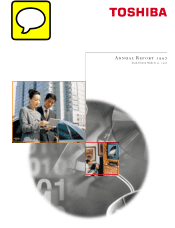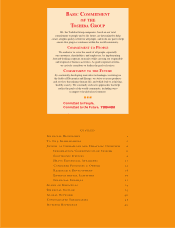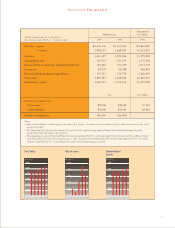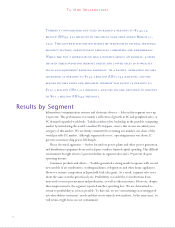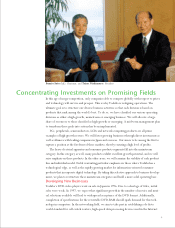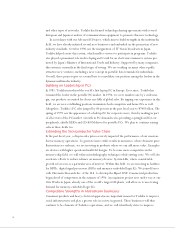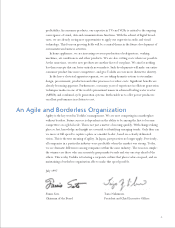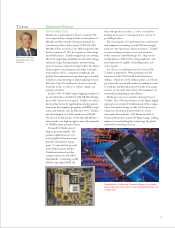Toshiba 1997 Annual Report Download - page 6
Download and view the complete annual report
Please find page 6 of the 1997 Toshiba annual report below. You can navigate through the pages in the report by either clicking on the pages listed below, or by using the keyword search tool below to find specific information within the annual report.4.
and other types of networks. Toshiba has formed technology sharing agreements with several
European and Japanese makers of communications equipment to promote this new technology.
In accordance with our Advanced-I Project, which aims to build strengths in the multimedia
field, we have already initiated several new businesses and embarked on the promotion of new
industry standards. October 1996 saw the inauguration of IT Vision broadcasts in Japan.
Toshiba helped create this system, which enables viewers to participate in programs. Toshiba
also played a prominent role in developing an IC card for an electronic commerce system pro-
moted by Japan’s Ministry of International Trade and Industry. Supported by many companies,
this system is currently in the final stages of testing. We are working on many other equally
attractive new ventures, including a new concept in portable data terminals for individuals.
Overall, these projects give us a sound base to consolidate our position among the leaders in the
dynamic multimedia industry.
Building on Leadership in PCs
In 1985, Toshiba introduced the world’s first laptop PC in Europe. Ever since, Toshiba has
remained the leader in the portable PC market. In 1996, we were number-one by a wide mar-
gin; our products accounted for about one-fifth of global sales. By tapping our experience in this
field, we are now establishing positions in mininotebook computers and home PCs as well.
Altogether, Toshiba’s PC sales jumped by 80 percent in the past fiscal year to ¥740 billion. The
spring of 1997 saw the appearance of a desktop PC for corporate users, thereby making us part
of all sectors of the PC market. Growth in PC demand is also providing a springboard for our
peripherals, chiefly HDDs and CD-ROM drives for portable PCs. We plan to continue raising
sales in these fields too.
Extending the Semiconductor Value Chain
In the past fiscal year, a drop in sales prices severely impacted the performance of our semicon-
ductor memory operations. To generate more stable results in memories, where dramatic price
fluctuations are endemic, we are investing in products where we can add more value. Examples
are devices with higher speeds and multi-bit designs. To become more competitive in the
memory chip field, we will refine microlithography techniques while cutting costs. We will also
accelerate efforts to reduce reliance on memory devices. System LSIs, where considerable
growth is foreseen, is a particular area of interest. Within this field, we are investing in facilities
for MPUs, digital signal processors (DSPs) and memory-embedded logic ICs. We joined forces
with Chromatic Research Inc. of the U.S. to develop the Mpact DSP. Commercial production
began ahead of competitors in the summer of 1996. An expansion project now under way at our
Oita Works in Japan, already one of the world’s largest LSI plants, will allow us to meet rising
demand for memory-embedded logic ICs.
Competitive Strengths in Mainstream Businesses
Consumer products and heavy electrical apparatus are important means for Toshiba to improve
social infrastructures and play a greater role in society in general. These businesses will thus
continue to be elements of Toshiba’s operations, and we will relentlessly strive to improve

